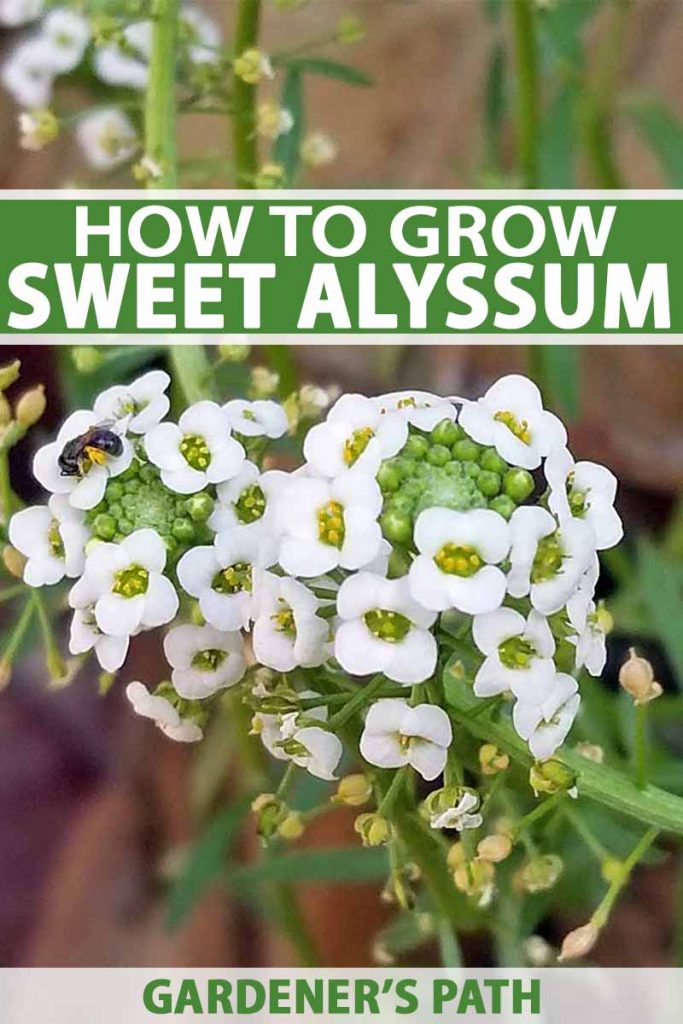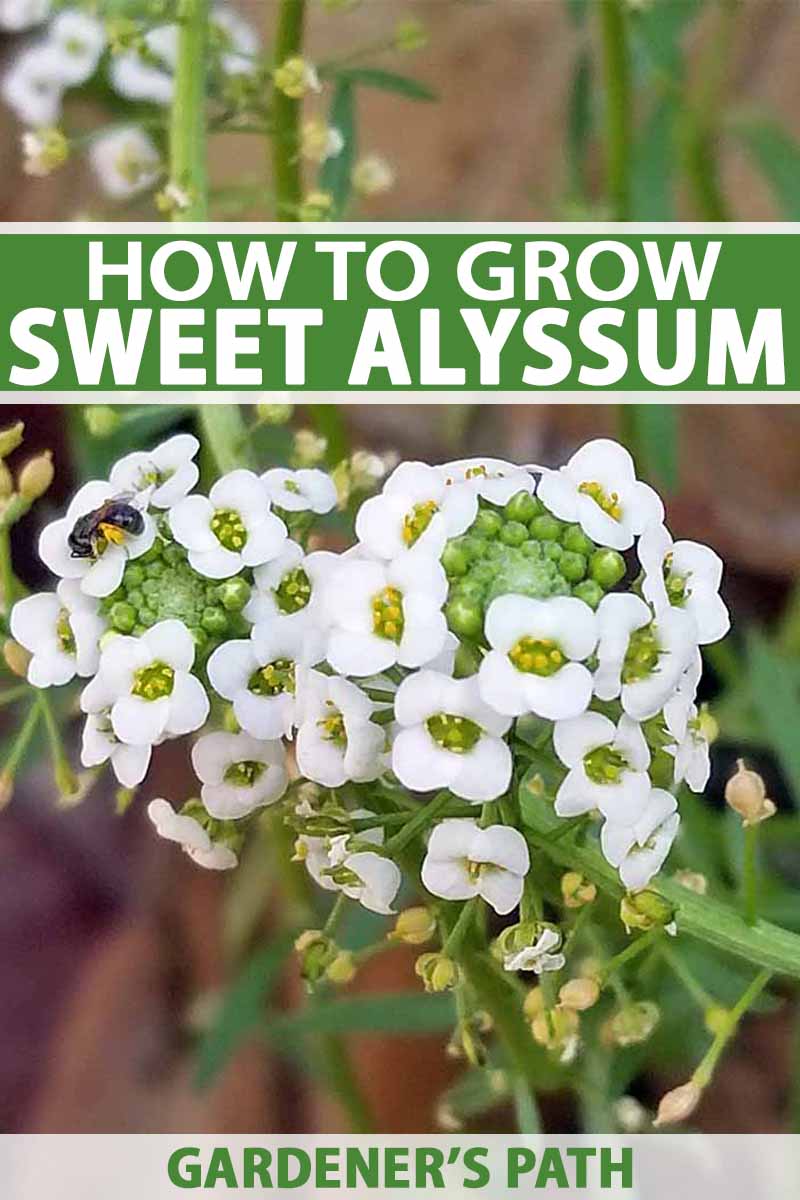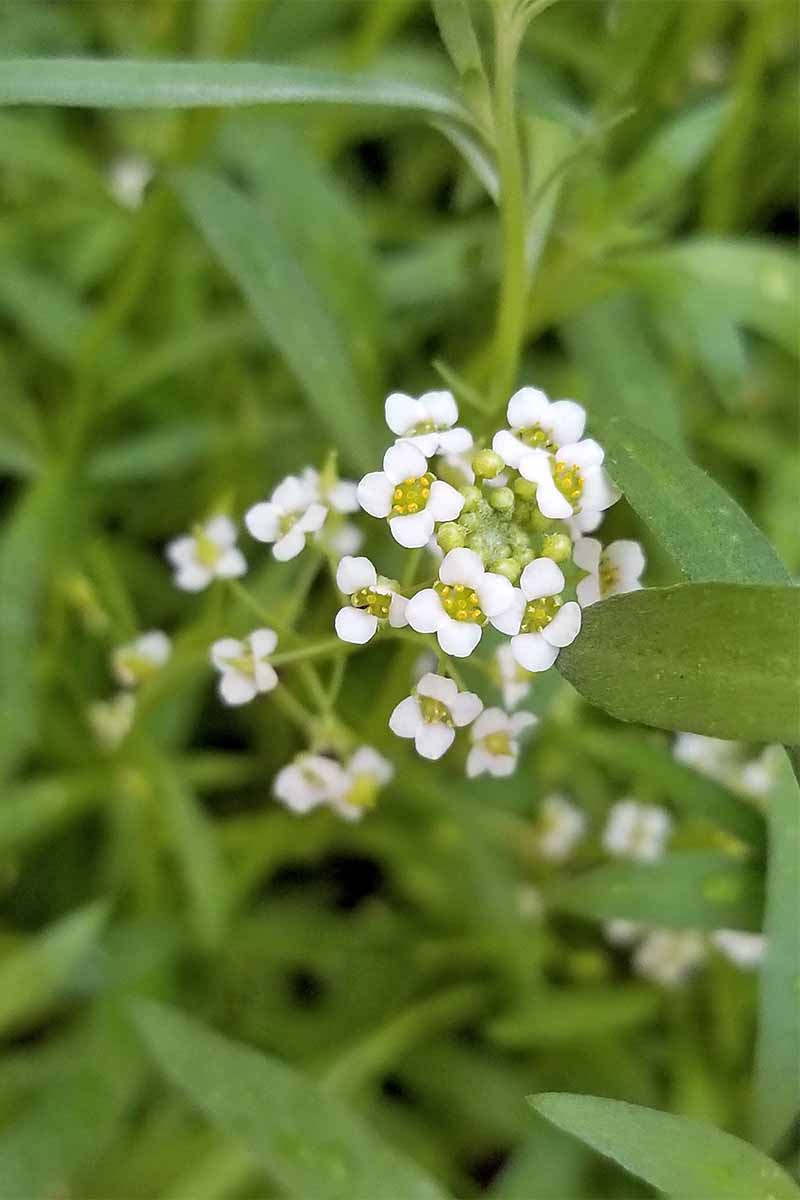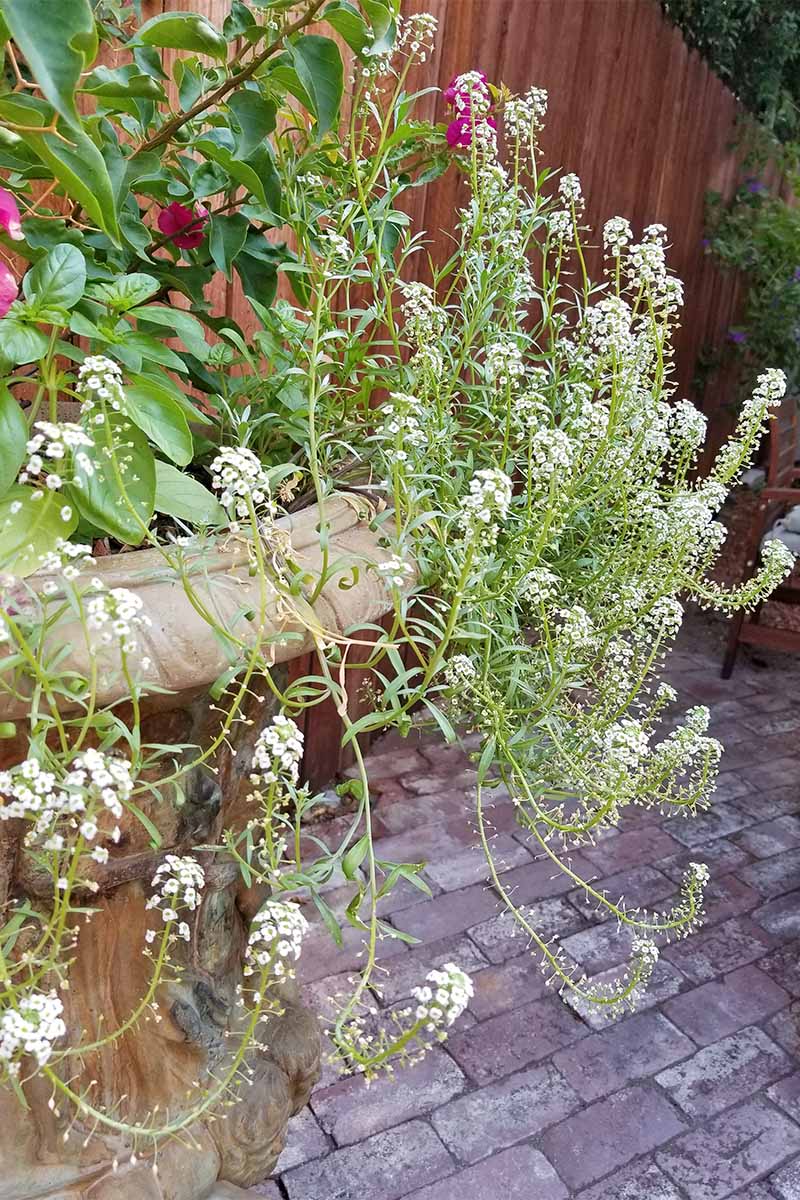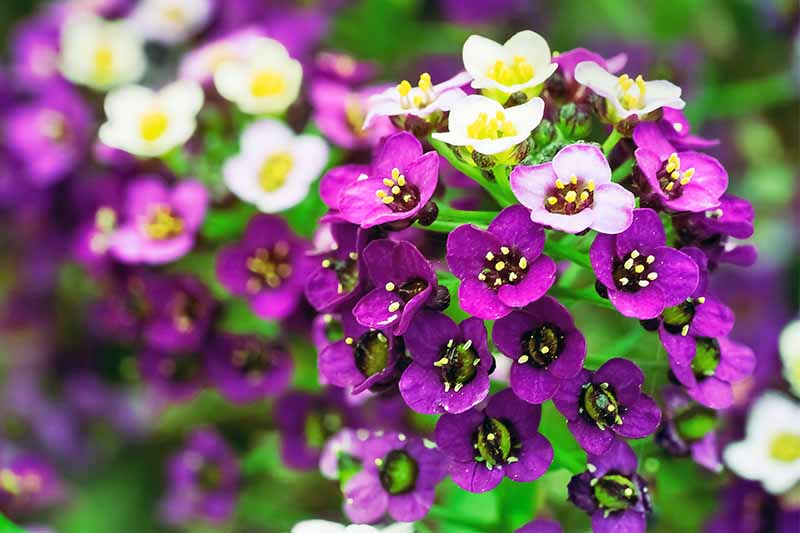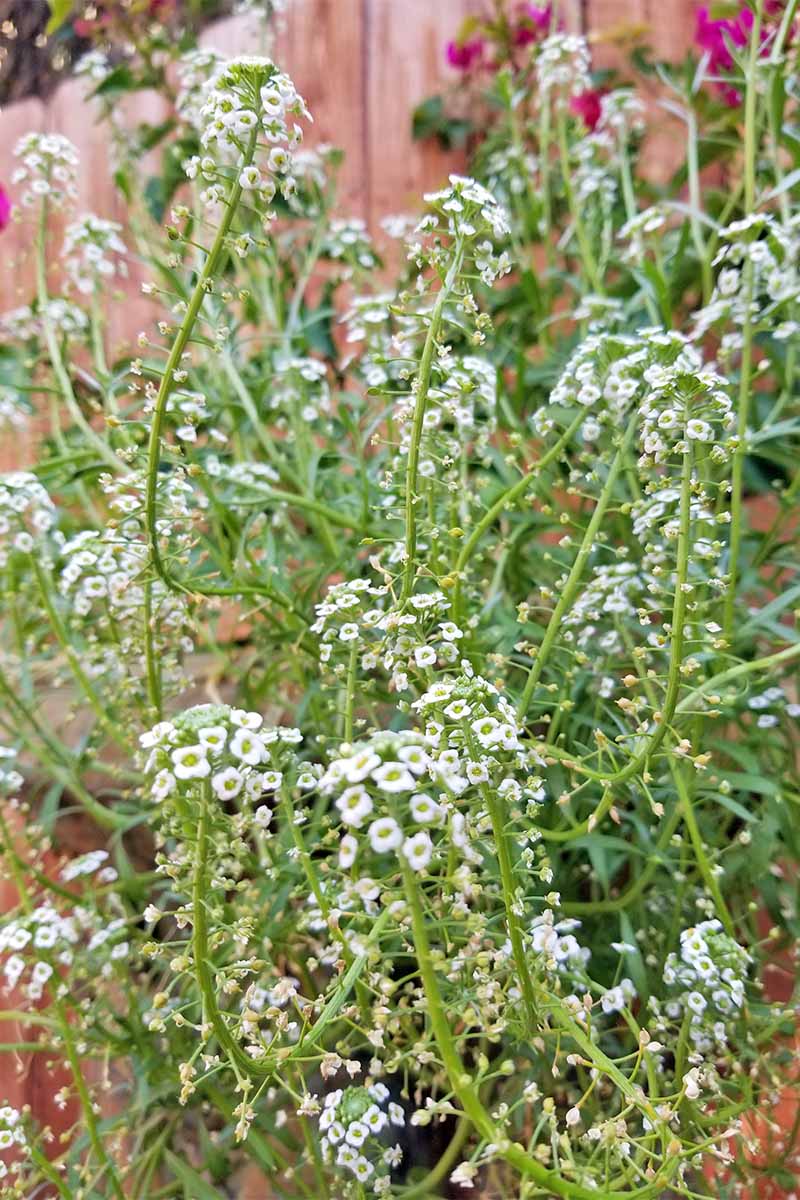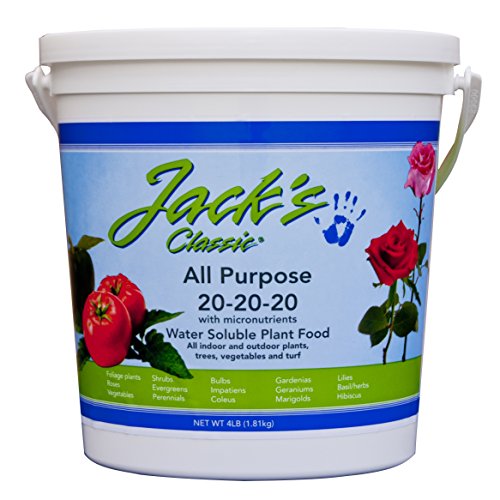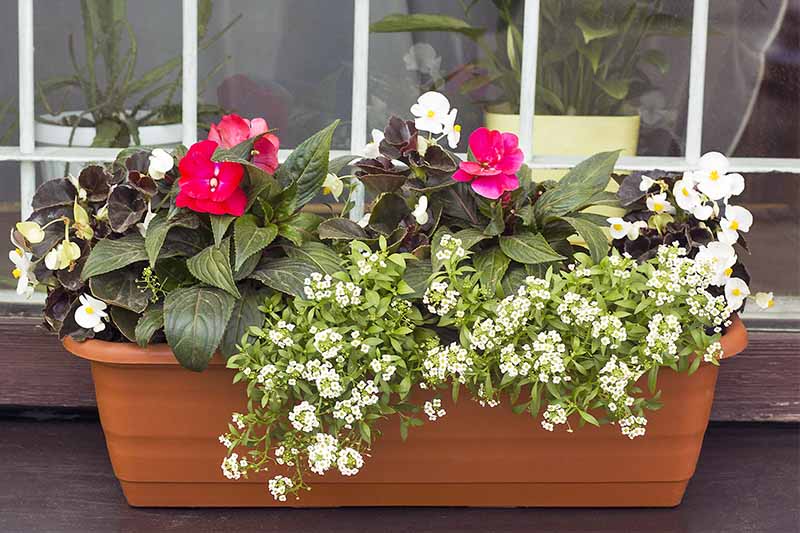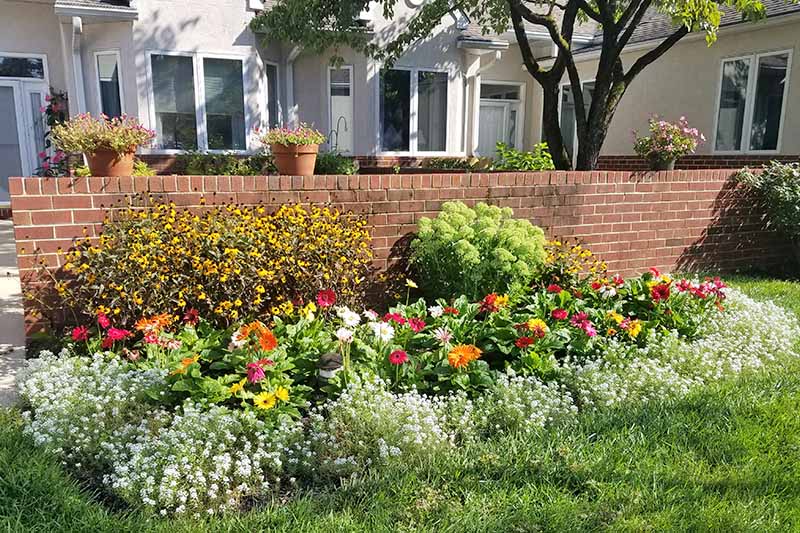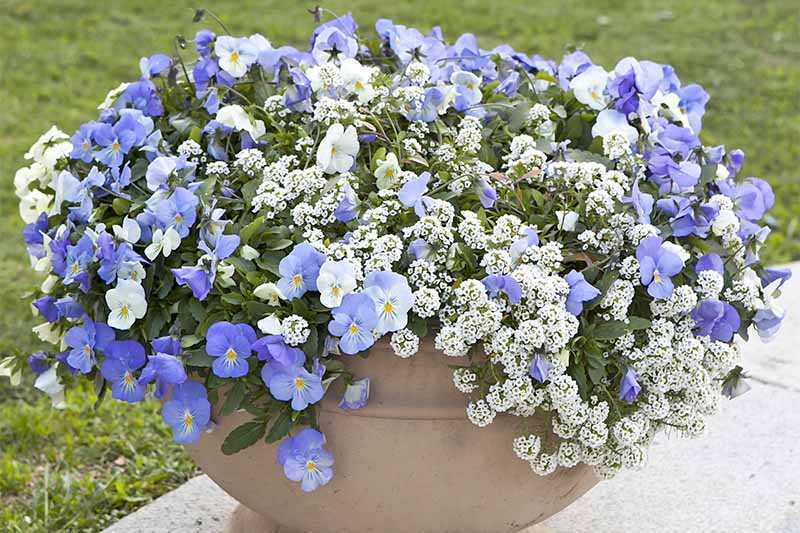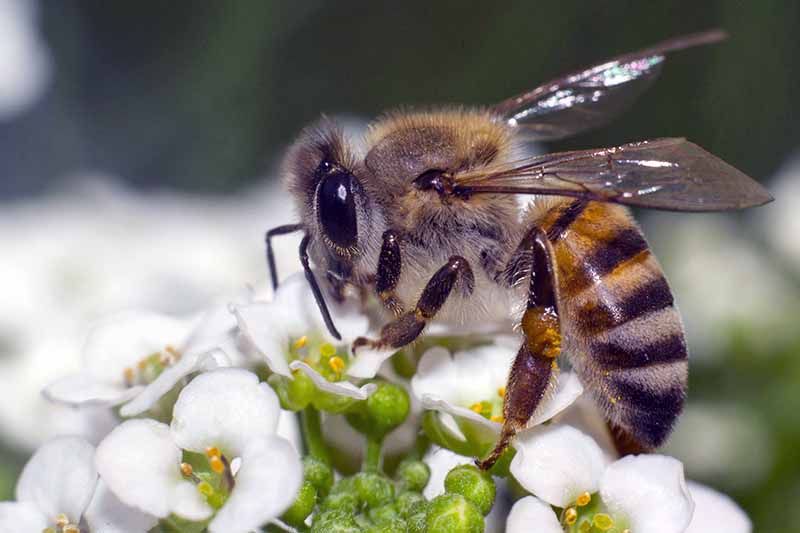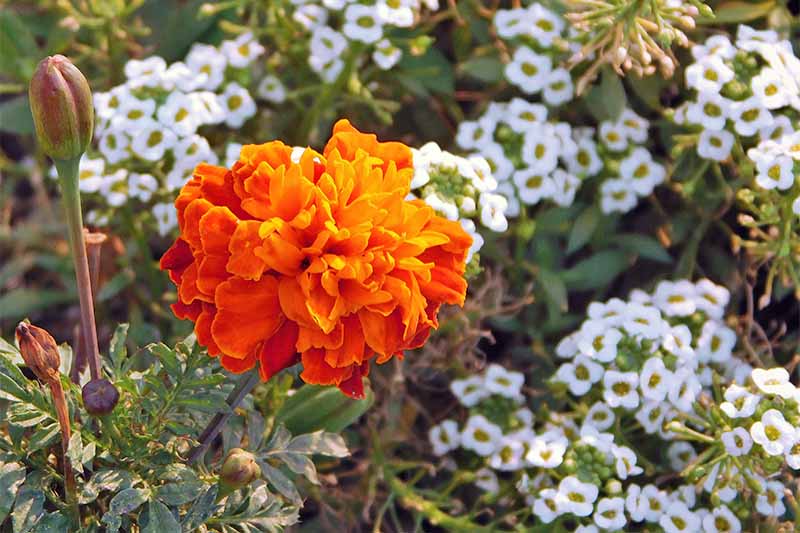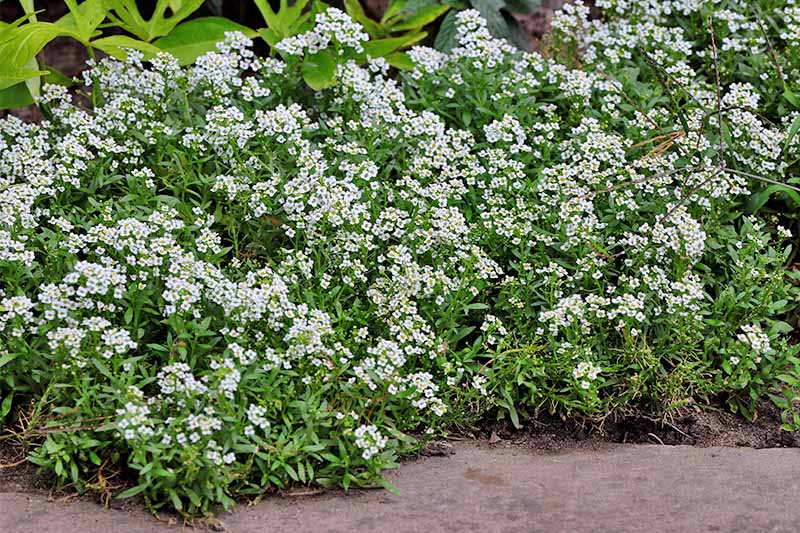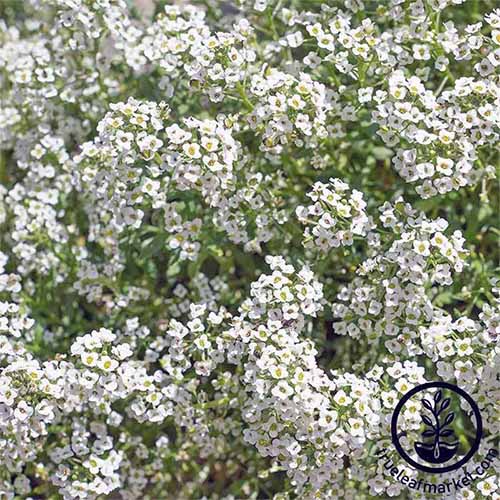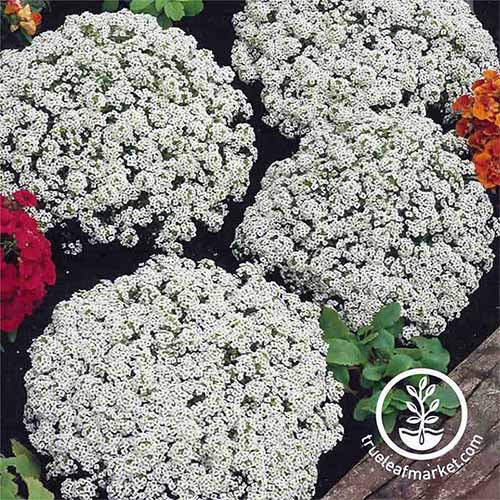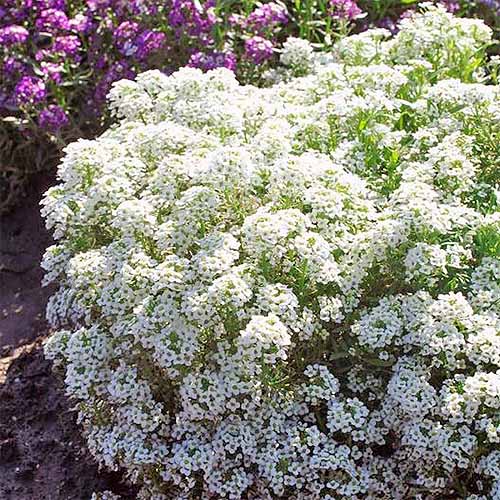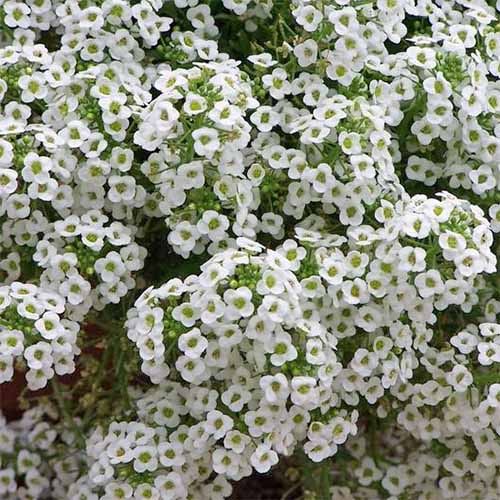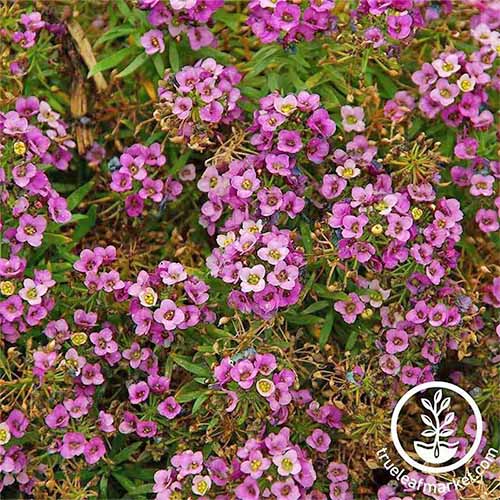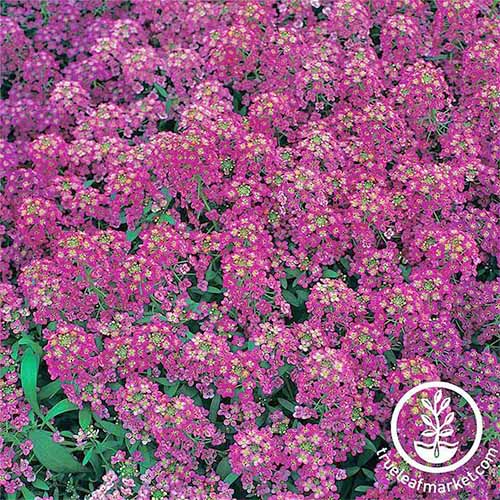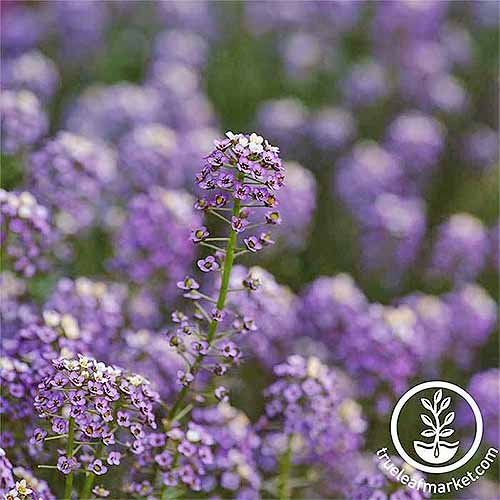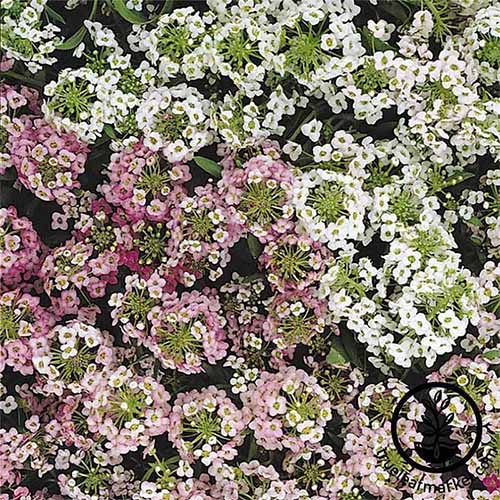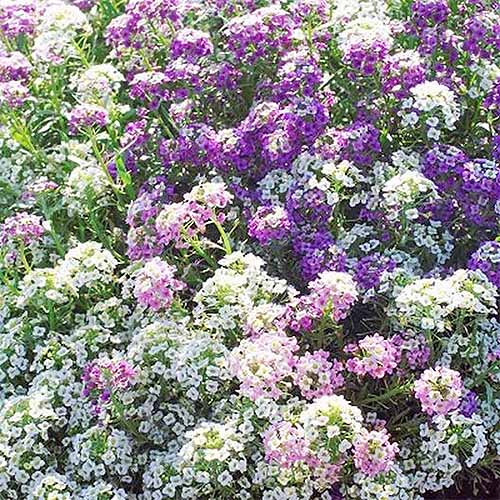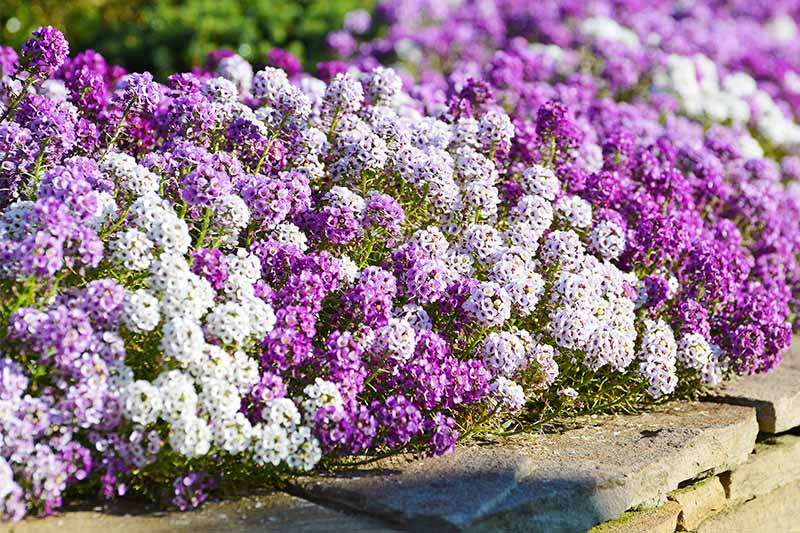Ladies and gentlemen, sweet alyssum is that flower. And if you aren’t familiar with it by now, prepare for a crash course in how to grow gorgeous Lobularia maritima. We link to vendors to help you find relevant products. If you buy from one of our links, we may earn a commission.
Why Sweet Alyssum?
Sweet alyssum (L. maritima) is flower that is happy to grow prolifically. Have a few empty patches in your yard or garden that are begging to be filled with a low-growing annual? Or are you looking for something to add soft texture to your seasonal containers? Alyssum is the solution! Perhaps you want a set-it-and-forget-it style of annual that will eagerly reseed for consecutive years. Maybe a pleasant looking ground cover is in order, to block weeds from sprouting up. Again, this is the plant for you. I’ve used L. maritima as ground cover in vegetable gardens to prevent weeds from coming back, and it doubles as an attractant to certain types of local pollinators. Plus, it’s low maintenance, and similar to vitex in the ease with which it spreads. And let’s not forget that sweet aroma! In the wide world of aromatic annuals, alyssum must rank near the top of the “Most Pleasant” category. That lovely scent is perfectly paired with the soft white, pink, or purple flowers of this plant. The tricky part is finding a reason not to grow L. maritima.
Okay, So What Does It Take to Grow?
Like all of my favorites, these annuals don’t require much attention.
While technically perennial in coastal regions (zones 9-11, typically) the plant is usually listed as a “hardy annual.” In my experience, this is because it can survive some light frosts and eagerly reseeds itself into the ground near where it was planted. Sweet alyssum prefers to have ample sunlight in most scenarios, especially for gardeners in more northern, cooler climates. However, if you live in a warmer environment, it’s good to give L. maritima a break from the sun during the hottest parts of the day. It prefers to be placed in an area with well-draining soil, but only needs extra watering the hottest and most dry periods of the summer. If alyssum doesn’t get enough sunlight or is too wet, it can develop problems with stem rot and blight. Run with the guideline of about 1 inch of rain required per week, with additional spot watering applied during dry and hot periods.
Suggested Placements and Uses
I use this flower in annual beds to create a gentle ring of color to frame the rest of the plants. Because it grows into a dense clump, it also minimizes weeds from poking through, and forms a strong bedline. Except for the aforementioned care regarding watering (to summarize, not too much!) L. maritima has few issues or special needs. Jack’s Classic 20-20-20 All-Purpose Fertilizer In a few weeks, you’ll have a flush of new growth and flowers. Or, you can let it continue to grow in containers for a trailing spill look. Because it self-seeds to readily, you may need to be careful of preventing alyssum from spreading to undesired portions of your yard. Errant or unwanted seed growth has rarely been an issue for me, but if you prefer a tight and formal style to your garden, you’ll need to be diligent.
While the seeds readily come back from parent plants, I’ve noticed that each successive generation is a bit weaker than the one before it. I’ll replace my L. maritima with new plants every three years or so, to keep them flushed and at their best. The white varieties are more resistant to heat and sun, but all alyssum cultivars will stop blooming during the hottest periods of the summer. Your plant isn’t dead if it stops blooming, it’s just taking a break to conserve energy for when the temperatures cool down a bit! In larger vegetable gardens where competition for space and nutrients isn’t an issue, I like to use L. maritima as a ground cover. It’s beautiful and helps to attract pollinators, and as long as I keep an eye on reseeding, it never grows out of bounds.
Sometimes regarded as a wildflower (though native to Europe), it grows in identical conditions as other flowers ideal for butterfly or pollinator-style gardens, and fills the role of ground cover very well. Placing sweet alyssum in your containers is another apt choice. Because it prefers well-drained soil, a container with proper drainage holes is the perfect placement.
This flower will fill in spaces and grow wide enough to form a soft-hued balancing act for your design, and it is happy to drape over the container sides without becoming a leggy or pendulous-looking affair like ivy and vinca vine tend to do.
What Pairs Well with This Flower?
Because it is usually a white, pink, or purple color, sweet alyssum pairs well with many other plants and color schemes. I have a fascination with growing whites and silvers together; this subtle color variation adds a world of texture and contrast paired with any other colors you choose. Geraniums and pansies come to mind as nice companion plants for alyssum that look lovely side by side. I’ve had luck combining L. maritima with straw flowers, Persian shield, dusty miller, osteospermum, and calibrachoa as well, just to name a few additional options!
L. maritima is an awesome addition to perennial beds, too, where you need pockets of space filled but you don’t want a permanent color to work around. I’ve nestled alyssum between black-eyed Susans, lavender, and gaillardia, and it pairs quite handsomely with any variety of thyme.
Alyssum is Pretty Sweet
From where I’m standing, it sure is! This flower is ideal for rock gardens, perennial beds, containers, vegetable rows, and just about anywhere else it can receive adequate sunlight and won’t be drowned. Because they grow so well from seed, I’m going to suggest you start your alyssum from scratch. It’s easy to find this plant in the springtime at your local garden center, but nothing beats growing your own from seed to flower. You can directly sow your seeds into the garden within a week of the last freeze date and watch them grow, but because they take about 50 days to reach maturity, you might have better luck starting your L. maritima indoors. Start your seeds about 6-8 weeks before the last frost date. Do not cover the seeds, just press them into the growing medium and water away! By the time the weather breaks, you’ll be able to condition your seedlings to the outdoor climate, and then plop them into your garden.
‘Carpet of Snow’ Seeds, available from True Leaf Market When planting in your garden, give them about 8 to 10 inches of space between plants to avoid overcrowding. Almost all alyssum cultivars will reach heights of about 4 to 8 inches and typically grow to form a 12-inch mound. How’s that for reliable? For the white options, try the ‘Carpet of Snow’ or ‘Snow Crystals’ cultivars.
‘Snow Crystals’ Seeds, available from True Leaf Market The latter is a tetraploid that forms more regularly-shaped mounds of canopy-like blooms, similar to yarrow, and has a stronger aroma than other varieties, while the former tends to be a little more wild and is less rigid, with smaller flower clusters that max out at about 6 inches in height. I’m a fan of ‘Carpet of Snow’ for borders, and ‘Snow Crystals’ for containers.
‘Tiny Tim’ Seeds, available from Eden Brothers For ground cover, ‘Tiny Tim’ is a winner. It maxes out at 3 inches tall, germinates in a week or less, and is perfect for growing between pavers. Taking the opposite tack, ‘Tall White’ will grow up to a foot in height.
‘Tall White’ Seed, available from Eden Brothers For hues in the pink and purple category, try ‘Rosie O’Day’ or ‘Royal Carpet,’ both lovely options.
‘Rosie O’Day’ Seeds, available from True Leaf Market I prefer the ‘Rosie O’Day’ variety because it has a softer color and serves as an accent other elements of your design, whereas the ‘Royal Carpet’ has a bolder look and is more of an attention grabber than I like ground cover to be.
‘Royal Carpet’ Seeds, available from True Leaf Market Can’t decide which to choose? Try a mixture!
‘Wonderland’ Series Seeds, available from True Leaf Market The ‘Wonderland’ Series has a variety of individual colors to choose from, but also includes a mixed option for the indecisive among us.
‘Easter Bonnet’ Series Seeds, available from True Leaf Market For softer hues, try the ‘Easter Bonnet’ Series Pastel Mix. This would be my top pick, because of the more subdued tones.
‘Magic Circle’ Seeds, available from Eden Brothers The ‘Magic Circle’ mix, available from Eden Brothers, provides a slightly more bold combination of purple, pink, and white. Add some near your herb garden, and brace yourself for a world of aromas to enjoy every day in the summer.
This has been a staple in my garden for years, and it will continue to be. Reliable plants tend not to be very appealing (if you ask me), but L. maritima breaks that trend and promises an easy-to-grow experience for each and every gardener. Thanks for reading! Please let me know what you think about L. maritima in the comments below, and check back soon for more from the folks here at Gardener’s Path! Pin image and credited photos by Allison Sidhu and Matt Suwak © Ask the Experts, LLC. ALL RIGHTS RESERVED. See our TOS for more details. Product photos via JR Peters Inc., Eden Brothers, and True Leaf Market. Uncredited photos: Shutterstock. With additional writing and editing by Allison Sidhu.
